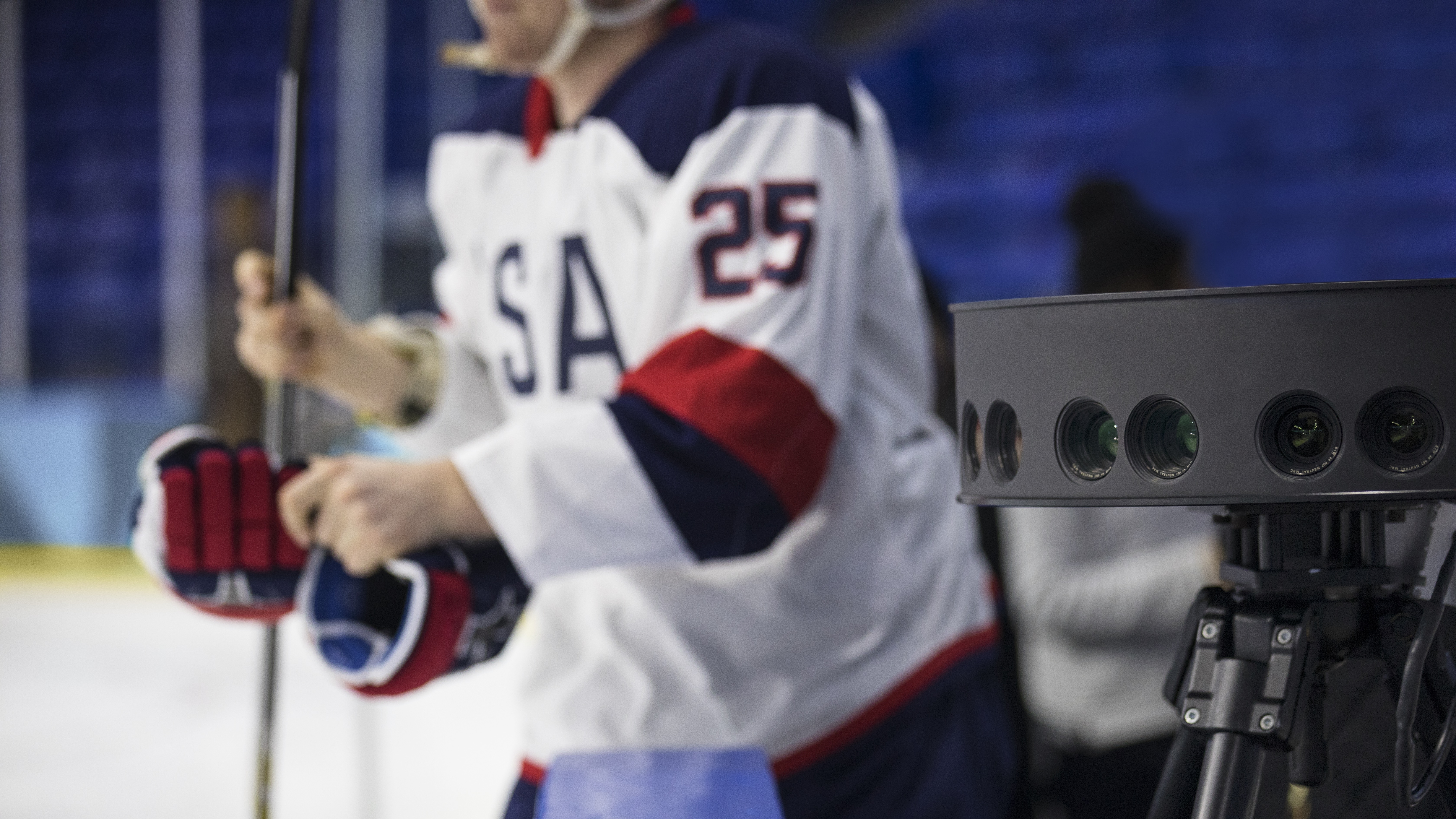Winter Olympics in VR isn't trying to be like watching the Games on TV
Intel's True VR tech is setting a course for the future

You've no doubt seen some Winter Olympics 2018 coverage, whether on television or social media. But, one of the most unique ways to experience this year's Winter Games can happen right on your face, thanks to virtual reality (VR).
Powered by Intel's True VR platform, the Olympics come alive in VR in a way you won't get watching on TV. While not the full breadth of events and encumbered by the dizzying effects of prolonged mobile VR use, this year's Olympics VR broadcast is a healthy preview for how we'll consume sporting events in the coming years.
"Really what we're doing around this experience is not try to take television and put it into VR, and we're not only trying to transport the fan to be at the event," David Aufhauser, Managing Director of Intel Sports, tells TechRadar. "We're creating an entirely new way for fans to experience the virtual world."
Working with its partner the Olympic Broadcast Services (OBS), Intel is recording 30 events for VR at the 2018 Winter Games, with more than half of those live. This is the first-ever live VR broadcast of the Winter Olympics, and a record number of events are being captured in virtual reality.

In the US, users can watch live and video-on-demand Olympics VR content through the NBC Sports VR app. Eurosport in Europe, the CBC in Canada, and other international OBS partners are providing this content to users in their respective regions.
In order to get the full VR experience, you'll need to slot your smartphone into a Google Cardboard, Google Daydream View, Samsung Gear VR or Windows Head Mounted Display headset, such as the Samsung HMD Odyssey or Lenovo Explorer. However, if you don't have a VR headset, you can still view 180- and 360-degree content on your iOS or Android phone.
Personalization is an important component of Intel's approach to VR broadcasts, Aufhauser says, as it allows users to customize their experience.
Get daily insight, inspiration and deals in your inbox
Sign up for breaking news, reviews, opinion, top tech deals, and more.
"You and I might be watching the same event at the same time, but you could be in one part of the arena, and I could be in another part of the arena, and someone else could be in the VR Cast, and we're all experiencing it in a completely different way. Even in a specific camera angle, you may be interested in one team, and I may be interested in the other team," he says.
Sure enough, we were able to jump around to different cameras placed throughout courses and arenas. Even within one camera angle, different users will surely fixate on different elements of the scene, whether it's the skier racing past the gates or the coach cheering them on further down the mountain.

Allowing VR broadcasts to be seen cross-platform is also hugely important for Intel, both in terms of reach and consumer adoption.
"We realize we're early days from a VR-adoption perspective," says Aufhauser. "So, in a way, we're teaching fans to VR. We're pulling them through the funnel."
That funnel starts with 180-degree and full panoramic videos, viewable on any mobile device. If they have one handy, users can switch back and forth to Google Cardboard. Eventually, they might decide to upgrade to a proper VR headset to get the full VR experience.
Tune in to win
We've spent quite a bit of time in the NBC Sports VR app using a Gear VR and Galaxy S7, checking out the various bits of content on offer.
There's plenty of it, from a presentation of the Opening Ceremonies to an experience that puts you in various positions around a curling rink, including right on top of the stone on the ice, looking up at the sweepers.
The content is varied and very well produced, and overall the app is easy to navigate. You truly do get a different perspective that you can't get on TV, or even if you were there in person. In real life, you can't stand at the starters box or in the middle of the course.
While some of the angle choices are a bit odd in the pre-recorded content – having a view of the audience during an ice skating competition, even for a short time, isn't exactly thrilling – in general we found the content enjoyable and compelling.
If you've always wanted to stand underneath a snowboarder as they somersault over you, now's your chance.

In order to watch a live Olympics VR broadcast, you need to tune in at a specific time. NBC has a schedule of these broadcasts available on its website. There is at least one live broadcast almost every day between now and the Closing Ceremony on February 25, including figure skating, alpine skiing, ski jumping and ice hockey.
Intel has done plenty of live VR broadcasts for various events before, but the scale to which it's doing them at the Winter Olympics is new, says Aufhauser.
Scale is an apt word in more ways than one. We donned the Gear VR to watch the live Women's Snowboard Halfpipe Final broadcast on Monday. Choosing from four different camera angles, we were able to position ourselves at the starting gate, at two points along the top of the halfpipe, and at the finish.
The perspectives gave a breathtaking sense of the scale of the halfpipe and the heights the athletes reach as they soar through the air. We could almost feel how crisp the air was, how dazzling the sun must have seemed, and how excited the crowd was, since we could hear their chatter in place of NBC's TV commentary.
If you've always wanted to stand underneath a snowboarder as they somersault over you, now's your chance
On the flip side, it was difficult to locate the competitors and figure out when the action was taking place. Without the curated camera angles and commentary of TV (however tiresome it can become), we were left on our own to figure out how to take in the event itself. Yes, it was immersive, and the scale of the halfpipe and size of the mountain were impressed upon us, but it wasn't an optimal set-up to actually watch the competition unfold.
VR ended up being a supplemental way for us to watch the event, rather than the primary one (we ultimately watched the last few runs on TV). But, if anything, seeing some of the event in VR gave us a deeper appreciation for the athletes' skill (not to mention bravery). And, for however many minutes we watched in VR, we truly got a sense of being there in person.
The future or a fad?
No matter how good the content, the question of whether watching major sporting events in VR can ever graduate from being a novelty remains. Is VR truly the future of content consumption, or just a passing fad?
"We look at it holistically," is Aufhauser's response to this question. "We're looking at immersive media, and VR is an important component of that. The idea around immersive media is that fans are moving from only a passive experience – whether on a mobile device or 70-inch screen at home, towards a fully immersive experience.
"So, yes, VR will be a very, very important way that fans will engage and interact with content. As more compelling experiences get developed, the more VR will be an important part of sports consumption."

TV may still be king of content consumption, but VR is starting to work its way in. Exact viewer numbers aren't yet forthcoming, but from our time watching the Winter Olympics broadcasts, we can say it's well worth checking them out in VR, if you own a headset.
For Intel, the Games will continue to be a proving ground for its technology, both for future Olympics (the 2020 Summer Olympics are right around the corner), and other major events throughout the year, including the NCAA March Madness basketball tournament, NBA All-Star Game and PGA golf.
"The Olympics has a history of and will continue to be a place to showcase how a technology can evolve and revolutionize how fans interact with content in general," says Aufhauser. "VR is such a great catalyst for that."
Michelle was previously a news editor at TechRadar, leading consumer tech news and reviews. Michelle is now a Content Strategist at Facebook. A versatile, highly effective content writer and skilled editor with a keen eye for detail, Michelle is a collaborative problem solver and covered everything from smartwatches and microprocessors to VR and self-driving cars.
